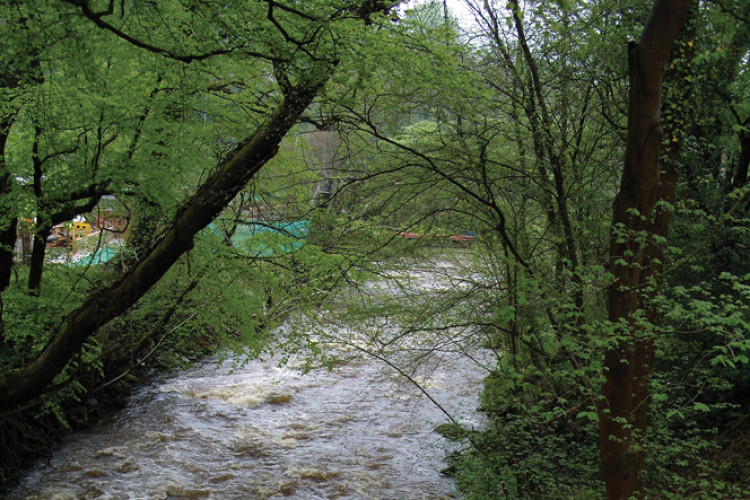Motorists travelling from the Midlands to south-west Wales have a choice of routes: they can head south to Bristol, cross the second Severn Crossing and take the M4 motorway via Newport and Cardiff; or they can take the scenic route.
The latter is the A465 Heads of the Valleys road which, as the name suggests, cuts across the top of the south Wales valleys through rolling countryside on the southern boundary of the Brecon Beacons national park.
The Heads of the Valleys road is prettier, more direct – and you don’t have to pay a toll. But for much of its length it is a single-carriageway, three-lane route that is both very busy and notoriously dangerous.
Almost since the road opened in the 1960s there has been talk of improvements to the route, but nothing happened until the beginning of this century when a scheme was agreed to upgrade the road in six phases to dual carriageway.
Section 4 (Tredegar to Dowlais) was completed in 2004, with Section 1 (Abergavenny to Gilwern) and Section 3 (Brynmawr to Tredegar) following in 2008 and 2015 respectively. Now Section 2 (Gilwern to Brynmawr), scheduled for completion by the end of next year, is currently underway with Costain as main contractor.
This £233m project involves dualling 8.1km of the road, which winds through hilly country, including the Clydach Gorge where the road is bounded on one side by a 30m-high rockface and on the other by a 20m drop down to the River Clydach. The road also climbs steeply from Gilwern to Brynmawr, 270m above.
The three-and-a-half year programme includes 16 major structures, including a 100m-span arched bridge over the Gorge, and entails around 1.1 million cubic metres of earthworks, with all the excavated material re-used for landscaping, fill and embankments.
Moving all this material in the famously wet climate of south Wales means a lot of mud is being generated with the very high risk of it being washed into watercourses, polluting groundwater and harming aquatic life.
And environmental protection is a dominant feature of this contract. The route lies almost entirely within the Brecon Beacons national park, which includes the River Usk Area of Special Conservation, two sites of special scientific interest (SSSIs), a geological SSI and several scheduled ancient monuments.
Controlling surface water runoff to minimise erosion and pollution is a major concern, says Hywel Woolf, Costain’s environmental advisor on the scheme. “We’re in an Environment Agency Source Protection Zone One, which is the most sensitive,” he says. Source Protection Zones identify groundwater sources and, in conjunction with Groundwater Protection Policies, are used to set up pollution prevention measures. Zone One areas are at the highest risk of contamination from activities that might cause pollution in the area.
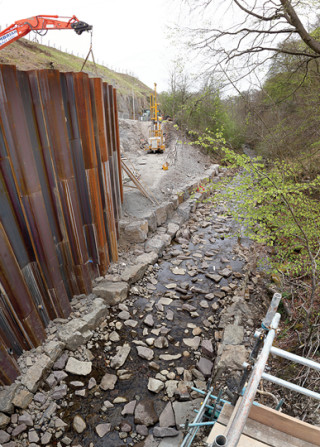
Treating the contaminated runoff from the road site is therefore a major challenge for Costain. “Everything combines to make this difficult,” says Woolf. “Climate, geology, steep valley sides, the size of the catchment area and lack of space all mean it’s difficult to intercept and treat runoff.”
The floodwater ‘curve’ following heavy rain shows a steep increase, peaking sharply before a gradual decline as surface water drains away or soaks into the ground. “The aim is always to slice the peak off the curve,” says Woolf, who explains that this is best done by diverting peak flows into temporary lagoons where the suspended solids can settle out. Unfortunately, there’s simply no space for such measures along the route of the A465.
Instead, Costain is using temporary water treatment systems supplied by local specialist Siltbuster to process silt-laden runoff. Three independent systems have been positioned at strategic locations along the route and dirty water is pumped into them from temporary sumps installed to collect the runoff.
The first line of defence, however, is a system of “silt fences” – some 12km of them – which intercept and slow the flow of water. These are simply fine-mesh geotextiles erected to waist-height perpendicular to the gradient of the land and held up with steel posts driven into the ground.
“They don’t actually filter the water,” explains Woolf. “What they do is slow the flow so the water doesn’t simply rush downhill in a torrent and take a lot of topsoil with it”.
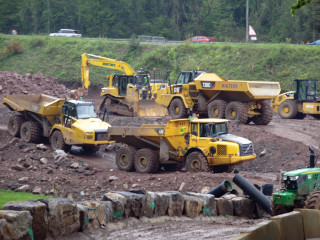
Siltbuster’s equipment comprises banks of lamella clarifiers (essentially, hoppers containing dozens of closely-packed lamellae, or thin steel plates) on which the suspended particles settle out. Each clarifier contains a lamella surface area of around 50m2. Before the water is pumped into the clarifiers, however, it needs to be dosed with chemicals to make the particles precipitate out.
“It’s all very technical and each application depends on the type of soils involved,” says Siltbuster sales manager Kristian Downs. “Sandy soils are easy – the particles settle very quickly,” he continues. “But clay soils can be very difficult because the particles form a colloidal mixture. You can leave that forever and it’ll never settle.”
Here in the Brecon Beacons, the ground is very variable but predominantly consists of glacial sediments containing a lot of clay. During the initial tender period, Siltbuster did a lot of research in order to find the most appropriate solution for the site. “We did a pre-contract survey with initial site walks where we collected samples of surface water from various locations,” says Downs.
The solution proposed by Siltbuster comprised three treatment systems, each consisting of 10 or 11 modular components. The water from the sump is first pumped into a machine where it is dosed with a coagulant that alters the electrical charge between the suspended particles so that they attract, rather than repel, each other.
From here, the water passes into another vessel where a polymer flocculent is introduced to bind the solid particles. After this, the treated water travels through the lamella clarifiers which collect the solids, allowing clean water to flow straight out and back into the watercourse. The largest system on the site can handle up to 180m3/hr.
Nothing is left to chance, and the effectiveness of the water treatment systems is constantly monitored and water quality regularly checked. “The regulator is Natural Resources Wales – the Welsh equivalent of the Environment Agency – and I speak to their representative about once every two or three days,” says Woolf.
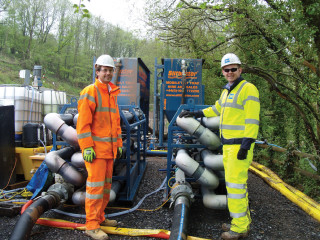
In addition, Woolf has two monthly meetings with NRW: one to review the water, waste and contaminated land, the other to discuss other ecological and environmental impacts, such as on plants and wildlife.
“We also keep in close contact with the two local authorities involved [Blaenau Gwent and Monmouthshire] as well as the Brecon Beacons national park,” adds Woolf.

Although Siltbuster carried out a survey of the project and put in a bid for the water treatment contract, the project actually went ahead with an alternative option. Cost was a factor, admits Woolf. Down concedes that Silbuster is “not the cheapest option” and its contract here is worth in the region of £7m.
Costain therefore initially opted for a combination of separate flocculators and electric coagulators rather than the modular system offered by Siltbuster. However the results were disappointing, says Woolf.
“The electric coagulators worked, but they were too slow, and the floc tanks were unmanageable and occupied too much space,” he explains. The performance was also marginal: “The maximum concentration of suspended solids in the effluent permitted by NRW is 100mg/litre and the floc tank was giving us 90mg/litre,” he says.
So after trialling a different system, Costain went back to Siltbuster and gave it the go-ahead. Now operating on site for over a year, the Siltbuster equipment has been producing clean water with a suspended solids content as low as 6mg/litre.
But it should be said that the margin for error with a system like this is very narrow and it doesn’t look after itself. When TCI visited the site during a very wet week in May, muddy water was running in rivulets all over the site and Siltbuster’s technical team was working overtime to regulate the flow through its equipment and balance the chemical dosing to ensure clean effluent.
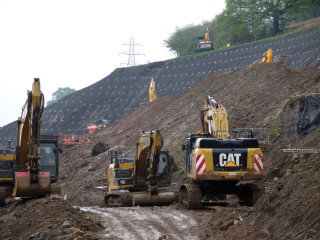
Siltbuster
Siltbuster was founded 15 years ago by Dr Richard Coulton, a mining engineer who worked on the remediation of the disused Wheal Jane tin mine in Cornwall during the 1990s.
After mining ceased in 1992, rising groundwater flushed acid water laden with heavy metals and arsenic out of the mine, causing widespread pollution as far downstream as Falmouth Bay.
Coulton set up Siltbuster Process Solutions shortly afterwards and the company now supplies mobile water treatment equipment to a variety of industrial users throughout the UK. It also exports to 40 countries.
Despite its international clientele, the A465 contract is right on Siltbuster’s doorstep – it is headquartered in Monmouth. This project is also the largest the company has undertaken to date, says sales manager Kristian Down.
Much of the company’s work is construction-related and focuses on removing suspended particles from runoff. “Our biggest competitor is the straw-bale,” says Down. However, the removal of dissolved contaminants generally requires are far more sophisticated techniques.
“For example, when you have lots of iron in the water, you can’t filter it out,” explains Down. “So what we do first is raise the pH to 8.5 and aerate it. This oxides the iron, which precipitates out to form iron hydroxide in suspension, which can then be filtered out.”
Sensitive environment
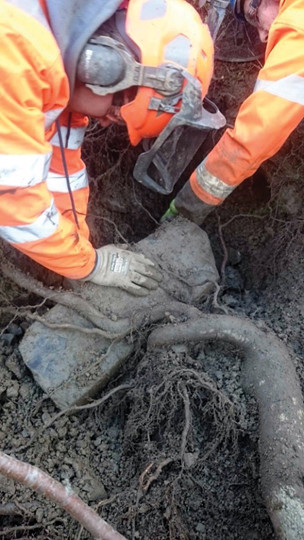
The Heads of the Valleys road passes through some highly sensitive sites and is home to several rare and endangered species. These include a population of lesser horseshoe bats whose breeding and foraging territory criss-crosses the route of the A465.
“The area is littered with caves where the bats roost and woodland where they forage for insects. A lot of that is being disturbed by the scheme,” explains Costain’s environmental advisor Hywel Woolf.
Bats are highly territorial and will not readily relocate when their homes are destroyed. Therefore, Costain has built a purpose-designed bat ‘maternity unit’ in a carefully chosen location on the northern edge of the site. The building, which resembles a cottage, has been constructed using local stone and sports a natural slate roof to ensure it blends into the landscape. Where woodland has been affected, young trees – up to three for every old tree felled – have been planted to maintain cover.
Another endangered species is a tree - the Welsh Whitebeam (sorbus cambrensis). This is one of the UK’s rarest trees; there are thought to be fewer than 100 of them and they are all located in the Brecon Beacons national park.
Two of them are within the corridor of the A465 scheme, with one in the footprint of the new alignment. The site’s restrictive topography meant there was no alternative but to move the tree.
Costain’s environmental consultant RPS and tree surgeon GT Jones used an AirSpade – an excavation tool that uses compressed air – to loosen and remove soil from around the tree’s rootball, which extended 7m from the trunk, without damage.
The tree was then relocated (together with several large rocks that sat within the rootball) to a new location. A weekly inspection regime is now in place to monitor the health of the tree which, so far at least, is doing well.
Costain academy
With a relatively high level of youth unemployment in south Wales, the A465 Heads of the Valleys Section 2 project has been identified by the Welsh government as a valuable opportunity for training. Hence Costain’s National Skills for Construction Academy which has been set up alongside the contractor’s site office and is providing training and skills development during the three-and-a-half year scheme.
The facility itself incorporates two integrated classrooms which can be opened out into one large room when for training courses, meetings and visits from local schools, colleges and community groups.
It also provides on-the-job training for Costain’s own apprentices. “We trained 20 apprentices here last year and 10 so far this year,” says Costain’s environmental advisor Hywel Woolf. “In total, Costain has trained 37 local young people since the end of 2014,” he adds.
The academy is equipped for online CSCS testing facilities and the Costain team is working closely with local primary and high schools to deliver STEM activities in collaboration with BTEC Careers Wales, CITB and Welsh technology training quango See Science.
Got a story? Email news@theconstructionindex.co.uk

